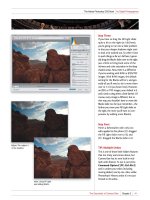The Adobe Photoshop CS5 Book for Digital Photographers part 13 pptx
Bạn đang xem bản rút gọn của tài liệu. Xem và tải ngay bản đầy đủ của tài liệu tại đây (1.24 MB, 10 trang )
ptg
101Chapter 4Camera Raw's Adjustment Tools
Continued
The Adobe Photoshop CS5 Book for Digital Photographers
Step 10:
Now that we have a few pins in place,
let’s switch to a different pin and tweak
that area. Click on the pin on the roof
on the left side of the station. Now raise
the Clarity amount to +75, and increase
the Sharpness amount to +36.
TIP: Deleting Adjustments
If you want to delete any adjustment
you’ve made, click on the adjustment’s
pin to select that adjustment (the cen-
ter of the pin turns black), then press
the Delete (PC: Backspace) key on
your keyboard.
Step 11:
If you make a mistake (like a spillover),
and accidentally paint over an area you
didn’t mean to paint over, you can erase
the spillover by either clicking on the
Erase radio button at the top of
the panel and then painting over those
areas, or just pressing-and-holding the
Option (PC: Alt) key, which temporarily
switches the brush to Erase mode. For
example, I moved my cursor over the
pin on the train to check how my paint-
ing went, and when the red mask
appeared, I could see that I acciden-
tally painted over the top of the train
a bit, so I clicked on that pin, then held
the Option key and painted over that
area (as shown here) until the spillover
was gone.
Download from www.wowebook.com
ptg
102
Chapter 4 Camera Raw's Adjustment Tools
The Adobe Photoshop CS5 Book for Digital Photographers
Step 12:
Here are a couple of other things about
the Adjustment Brush you’ll want to know:
The Feather slider controls how soft the
brush edges are—the higher the number,
the softer the brush (I paint with a soft
brush about 90% of the time). For a hard-
edged brush, set the Feather slider to 0.
The Flow slider controls the amount of
paint that comes out of the brush (I leave
the Flow set at 50 most of the time).
Below is a before/after, which shows
how useful dodging and burning with
the Adjustment Brush can be.
Before After
Download from www.wowebook.com
ptg
103Chapter 4Camera Raw's Adjustment Tools
The Adobe Photoshop CS5 Book for Digital Photographers
Continued
One of the main things we’ve always had to go to Photoshop for was retouching
portraits, but now, by using the Spot Removal tool, along with the Adjustment
Brush, we can do a lot of simple retouching jobs right here in Camera Raw,
where they’re completely non-destructive and surprisingly flexible.
Retouching
Portraits in
Camera Raw
Step One:
In the portrait shown here, we need
to do some basic fixes first (the white
balance, for one, is way off), then we
want to make three retouches: (1) we
want to lighten and brighten her eyes,
(2) we want to remove any blemishes
and soften her skin, and (3) we want
to sharpen her eyes and eyelashes.
These were all things we’d have to
go into Photoshop for, but now we
can do all three right here in Camera
Raw. Let’s start by fixing the white bal-
ance first, then we’ll do the retouch. The
image at the top here shows the As Shot
white balance, which is way too blue.
From the White Balance pop-up menu,
choose Flash (since the photo was taken
with a studio flash), which gets rid of
the blue, but for this particular image,
to me it makes it look too warm (yel-
low), so drag the Temperature slider to
the left a bit (as shown in the bottom
image) until the skin tones look about
right (not too yellowish). Next, we’ll do
some retouching, and we’ll start with
brightening the whites of her eyes.
SCOTT KELBY
Download from www.wowebook.com
ptg
104
Chapter 4 Camera Raw's Adjustment Tools
The Adobe Photoshop CS5 Book for Digital Photographers
Step Two:
First, select the Zoom tool (Z) from
the toolbar, and click on the image to
zoom in a bit closer, so you can see the
eyes clearly. Now get the Adjustment
Brush (K), then in the Adjustment
Brush panel on the right, click three
times on the + (plus sign) button to
the right of the Brightness slider to
increase the Brightness amount to
+75. Choose a small brush size using
the Size slider, then paint directly over
the whites of her eyes (as shown here)
and, in this case, probably her irises,
as well, to brighten them. If they look
too bright, we can always lower the
Brightness amount after the fact.
Step Three:
Next, we’ll remove some facial blem-
ishes, so zoom in tight on an area where
you see some, and then get the Spot
Removal tool (B; its icon looks like a
brush with sparkles around it, and it’s
circled here in red). This brings up the
Spot Removal options panel, and the
only thing you need to do here is make
sure the Type pop-up menu is set to
Heal (rather than Clone). Now, you just
click directly on the blemish you want
to remove, and draw outward. As you
do, a little red circle will appear that
grows in size as you drag. Make that red
circle a little bigger than the blemish
and then let go of your mouse button.
A green second circle will appear, which
shows where it’s sampling skin from to
repair your blemish. If, for some reason,
it didn’t pick a good patch of smooth
skin (and your retouch doesn’t look
good), click on this second circle, drag
it to another nearby area, and it will
resample that skin area, which should
do the trick. Go ahead and remove all
the blemishes.
Download from www.wowebook.com
ptg
105Chapter 4Camera Raw's Adjustment Tools
The Adobe Photoshop CS5 Book for Digital Photographers
Step Four:
Switch back to the Adjustment Brush,
then click the – (minus sign) button be-
side Clarity four times to set the Clarity
amount at –100 (this is called “negative
clarity” by people who love to give every-
thing a name). Increase the size of your
brush (by using either the Size slider or
the Right Bracket key on your keyboard),
and then paint over her skin to soften
it, but be careful to avoid any areas that
should stay sharp and have lots of detail,
like the eyebrows, eyelids, lips, nostrils,
hair, etc. (as shown here). Lastly, click on
the New radio button, set the Sharpness
to +100 and Clarity to +25, then paint over
the irises of her eyes and her eyelashes to
help make them look sharper and more
crisp, which completes the retouch (a be-
fore/after is shown below).
I fixed the white balance for both, but in the After photo on the right, the whites and irises of her eyes are now brighter,
her blemishes have been removed, her skin has been softened, and her irises and eyelashes have been sharpened.
Download from www.wowebook.com
ptg
106
Chapter 4 Camera Raw's Adjustment Tools
The Adobe Photoshop CS5 Book for Digital Photographers
Fixing Skies
(and Other Stuff)
with the
Graduated Filter
The Graduated Filter (which acts more like a tool) lets you recreate the look of a
traditional neutral density gradient filter (these are glass or plastic filters that are
dark on the top and then graduate down to fully transparent). They’re popular with
landscape photographers because you’re either going to get a photo with a perfect-
ly exposed foreground, or a perfectly exposed sky, but not both. However, with the
way Adobe implemented this feature, you can use it for much more than just neu-
tral density gradient effects (although that probably will still be its number one use).
Step One:
Start by selecting the Graduated Filter
tool (G) up in the toolbar (it’s shown
circled in red here). When you click on it,
its options panel appears (shown here)
with a set of effects you can apply that
are similar to the ones you can apply
using the Adjustment Brush. Here we’re
going to replicate the look of a tradi-
tional neutral density gradient filter and
darken the sky. Start by dragging the
Exposure slider to the left, or just click
on the – (minus sign) button two times
to get to –1.00 (as seen here).
Step Two:
Press-and-hold the Shift key (to keep
your gradient straight), click at the top
center of your image, and drag straight
down until you reach the top of the big
stand of trees (as shown here). Generally,
you want to stop dragging the gradi-
ent before it reaches the horizon line,
or it will start to darken your properly
exposed foreground. You can see the
darkening effect it has on the sky and
the photo already looks more balanced.
Note: Just let go of the Shift key to drag
the gradient in any direction.
SCOTT KELBY
Download from www.wowebook.com
ptg
107Chapter 4Camera Raw's Adjustment Tools
The Adobe Photoshop CS5 Book for Digital Photographers
Step Three:
The green pin shows the top of your
gradient; the red pin shows the bottom.
In this case, we’d like the sky a little
darker still, so drag the Brightness (mid-
tones) slider to the left a bit to darken
the midtones in the sky (don’t click the
+ or – [plus or minus sign] buttons, or
it will reset the Exposure slider to 0).
What’s nice about this tool is, like the
Adjustment Brush, once we’ve dragged
out the Graduated Filter, we can add
other effects to that same area. So, if
you’d like the sky to be bluer, you can
click on the Color swatch, and when
the Color Picker appears, click on a blue
color to complete your effect.
TIP: Gradient Tips
You can reposition your gradient after
the fact—just click-and-drag downward
on the line connecting the green and red
pins to move the whole gradient down.
Click-and-drag either pin to rotate your
gradient after it’s in place. You can also
have more than one gradient (click on the
New radio button at the top of the panel)
and to delete a gradient, just click on it
and press the Delete (PC: Backspace) key.
Before After
Download from www.wowebook.com
ptg
108
Chapter 4 Camera Raw's Adjustment Tools
The Adobe Photoshop CS5 Book for Digital Photographers
Step One:
For the first effect (where we make one
part of the image stand out by leaving
it in color, while the rest of the image is
black and white), we want to set up the
Adjustment Brush so it paints in black and
white, so start by getting the Adjustment
Brush (K), then in the Adjustment Brush
options panel, click on the – (minus sign)
button to the left of Saturation four times
to set the brush so it paints with –100
saturation. Why didn’t we just drag the
Saturation slider all the way to the left? It’s
because by clicking on that – button first,
all the other sliders are zeroed out, so we
don’t accidentally adjust something else at
the same time.
Step Two:
In just a moment, we’re going to paint
over most of the image, and this will
go a lot faster if you turn off the Auto
Mask checkbox near the bottom of
the panel (so it’s not trying to detect
edges as you paint). Once that’s off, make
your brush nice and big (drag the Size
slider to the right or press the Right
Bracket key), and paint over most of
the image, but make sure you don’t
get too close to the area right around
the bouquet, as shown here, where I left
about a ½" area untouched all around
the bouquet.
There are some really nice special effects you can apply from right within Camera
Raw itself, and some of these are easier to achieve here than they are by going
into the rest of Photoshop and doing it all with layers and masks. Here are two
special effects that are popular in portrait and wedding photography: (1) drawing
attention by turning everything black and white, but leaving one key object in full
color (very popular for wedding photography and photos of kids), and (2) creat-
ing a soft, dramatic spotlight effect by “painting with light.”
Special Effects
Using Camera Raw
SCOTT KELBY
Download from www.wowebook.com
ptg
109Chapter 4Camera Raw's Adjustment Tools
Continued
The Adobe Photoshop CS5 Book for Digital Photographers
Step Three:
Now you’ll need to do two things:
(1) make your brush size smaller, and
(2) turn on the Auto Mask checkbox.
The Auto Mask feature is really what
makes this all work, because it will
automatically make sure you don’t
accidentally make the object in your
image that you want to remain color,
black and white, as long as you follow
one simple rule: don’t let that little
plus-sign crosshair in the center of the
brush touch the thing you want to stay
in color (in our case, it’s the bouquet
of flowers). Everything that little cross-
hair touches turns black and white
(because we lowered the Saturation to
–100), so your job is to paint close to
the flowers, but don’t let that crosshair
actually touch the flowers. It doesn’t
matter if the edges of the brush (the
round rings) extend over onto the flow-
ers (in fact, they’ll have to, to get in
really close), but just don’t let that little
crosshair touch, and you’ll be fine. This
works amazingly well (you just have to
try it for yourself and you’ll see).
Step Four:
Here, we’ve painted right up close to the
bouquet and yet the flowers and even
the green leaves are still in color because
we were careful not to let that crosshair
stray over onto the flowers. Okay, now
let’s use a similar technique in a different
way to create a different effect using the
same image. Start by pressing the Delete
(PC: Backspace) key to get rid of this ad-
justment pin and start over from scratch
with the original color image.
Download from www.wowebook.com
ptg
110
Chapter 4 Camera Raw's Adjustment Tools
The Adobe Photoshop CS5 Book for Digital Photographers
Step Five:
Here’s the original full-color image again.
Get the Adjustment Brush and click the
– (minus sign) button beside Exposure
to zero everything out. Then drag the
Exposure slider down to around –1.35
and drag the Brightness slider down to
around –45, as shown here.
Step Six:
Turn of f the Auto Mask checkbox, and
using a large brush, paint over the entire
image (as shown here) to greatly darken it.
Download from www.wowebook.com









